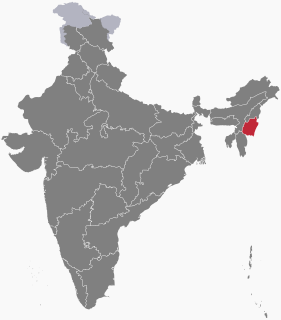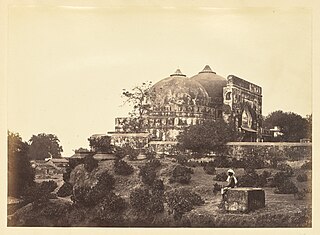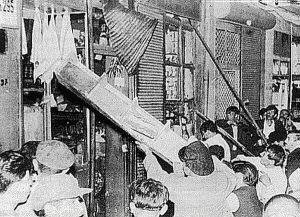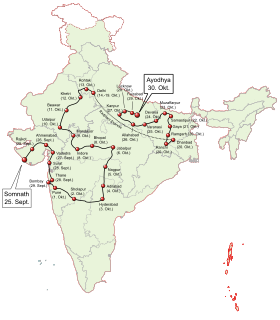 W
WReligious violence is a term that covers phenomena where religion is either the subject or the object of violent behavior. Religious violence is violence that is motivated by, or in reaction to, religious precepts, texts, or the doctrines of a target or an attacker. It includes violence against religious institutions, people, objects, or events. Religious violence does not exclusively refer to acts which are committed by religious groups, instead, includes acts which are committed against religious groups.
 W
WThe 1993 Pangal massacre refers to the massacre in Pangal, an indigenous Muslim community in Manipur, India, by the Meitei people, who are the majority ethnic group of Manipur and are largely Hindu, on 3 May 1993.
 W
WOn 28 February 2013, the International Crimes Tribunal sentenced Delwar Hossain Sayeedi, the vice-president of the Jamaat-e-Islami to death for war crimes committed during the 1971 Bangladesh Liberation War. Following the sentence, activists of Jamaat-e-Islami and its student wing Islami Chhatra Shibir attacked Hindus in different parts of the country. Hindu properties were looted, Hindu houses were burnt into ashes and Hindu temples were desecrated and set on fire. While the government has held the Jamaat-e-Islami responsible for the attacks on minorities, the Jamaat-e-Islami leadership has denied any involvement. Minority leaders have protested the attacks and appealed for justice. The Supreme Court of Bangladesh has directed law enforcement to start suo motu investigation into the attacks. The US Ambassador to Bangladesh expressed concern about attacks by Jamaat on the Bengali Hindu community.
 W
WOn the night of 11 August 2020, violent clashes took place in the Indian city of Bangalore, Karnataka. Provoked by an inflammatory Facebook post on Muhammad that was allegedly shared by the nephew of the Akhanda Srinivas Murthy, a state legislator of the Indian National Congress, a Muslim mob arrived at his house in protest which turned violent.
 W
WThe 2014 anti-Muslim riots in Sri Lanka were religious and ethnic riots in June 2014 in south-western Sri Lanka. Muslims and their property were attacked by Sinhalese Buddhists in the towns of Aluthgama, Beruwala and Dharga Town in Kalutara District. At least four people were killed and 80 injured. Hundreds were made homeless following attacks on homes, shops, factories, mosques and a nursery. 10,000 people were displaced by the riots. The riots followed rallies by Bodu Bala Sena (BBS), a hard line Buddhist group. The BBS was widely blamed for inciting the riots but it has denied responsibility. The mainstream media in Sri Lanka censored news about the riots following orders from the Sri Lankan government.
 W
WThe Sri Lankan anti-Muslim riots were a series of religious riots targeting Muslims that began in the Sri Lankan town of Ampara on 26 February 2018, spreading to Kandy District by 2 March until its end on 10 March 2018. Muslim citizens, mosques and other properties were attacked by mobs of Sinhalese Buddhists, and mobs of Muslims attacked Buddhists Temples and Sinhalese citizens. The Government of Sri Lanka undertook a forceful crackdown on the rioting by imposing a state of emergency and deploying the Sri Lankan Armed Forces to assist the Police in the affected areas. The situation was brought under control by 9 March. Two fatalities and ten injuries were reported among Sinhalese, Muslims and Police. According to the police, forty five incidents of damage to houses and businesses have been reported, while four places of worship have been attacked. The police arrested 81 persons in connection with rioting.
 W
WThe Sri Lankan anti-Muslim riots were a series of religiously motivated riots targeting Muslims in Sri Lanka. The riots originated as isolated incidents in the aftermath of the Easter bombings in the nation, beginning in Chilaw and subsequently spreading to much of the Northwestern Province.
 W
WThe demolition of the Babri Masjid was illegally carried out on 6 December 1992 by a large group of activists of the Vishva Hindu Parishad and allied organisations. The 16th-century Babri Mosque in the city of Ayodhya, in Uttar Pradesh, had been the subject of a lengthy socio-political dispute, and was targeted after a political rally organised by Hindu nationalist organisations turned violent.
 W
WBaduria riot refers to incidents of communal violence in the Baduria town in Basirhat subdivision of the North 24 Parganas district of West Bengal state of India.
 W
WBeeldenstorm in Dutch, and Bildersturm in German are terms used for outbreaks of destruction of religious images that occurred in Europe in the 16th century, known in English as the Great Iconoclasm or Iconoclastic Fury. During these spates of iconoclasm, Catholic art and many forms of church fittings and decoration were destroyed in unofficial or mob actions by Calvinist Protestant crowds as part of the Protestant Reformation. Most of the destruction was of art in churches and public places.
 W
WThe 2020 Delhi riots, or North East Delhi riots, were multiple waves of bloodshed, property destruction, and rioting in North East Delhi, beginning on 23 February and caused chiefly by Hindu mobs attacking Muslims. Of the 53 people killed, two-thirds were Muslims who were shot, slashed with repeated blows, or set on fire. The dead also included a policeman, an intelligence officer and over a dozen Hindus, who were shot or assaulted. More than a week after the violence had ended, hundreds of wounded were languishing in inadequately staffed medical facilities and corpses were being found in open drains. By mid-March many Muslims had remained missing.
 W
WThe 1964 East Pakistan Riots refer to the alleged massacre and ethnic cleansing of Bengali Hindus from East Pakistan in the wake of an alleged theft of what was believed to be the Prophet's hair from the Hazratbal shrine in Jammu and Kashmir in India. The salient feature of the pogroms was its urban nature and selective targeting of Bengali Hindu owned industries and merchant establishments in the capital city of Dhaka. This resulted in unending waves of Bengali Hindu refugees in neighbouring West Bengal. The refugee rehabilitation became a national problem in India, and hundreds of refugees were resettled in Dandakaranya region of Odisha & Madhya Pradesh.
 W
WThe Gordon Riots of 1780 were several days of rioting in London motivated by anti-Catholic sentiment. They began with a large and orderly protest against the Papists Act of 1778, which was intended to reduce official discrimination against British Catholics enacted by the Popery Act 1698. Lord George Gordon, head of the Protestant Association, argued that the law would enable Catholics to join the British Army and plot treason. The protest led to widespread rioting and looting, including attacks on Newgate Prison and the Bank of England and was the most destructive in the history of London.
 W
WThe 1969 Gujarat riots refer to the communal violence between Hindus and Muslims during September–October 1969, in Gujarat, India. The violence was Gujarat's first major riot that involved massacre, arson and looting on a large scale. It was the most deadly Hindu-Muslim violence since the partition of India in 1947, and remained so until the 1989 Bhagalpur violence.
 W
WThe 1985 Gujarat riots began in February 1985 and lasted till August, in the Indian state of Gujarat. Most of the rioting occurred in the city of Ahmedabad; some other cities, including the state capital of Gandhinagar, were also affected. Between 220 and 275 people were killed in the violence, while several thousands of others were injured, and tens of thousands were displaced. The riots also caused widespread property damage.
 W
WThe 2002 Gujarat riots, also known as the 2002 Gujarat violence and the Gujarat pogrom, was a three-day period of inter-communal violence in the western Indian state of Gujarat. The burning of a train in Godhra on 27 February 2002, which caused the deaths of 58 Hindu pilgrims karsevaks returning from Ayodhya, is cited as having instigated the violence. Following the initial riot incidents, there were further outbreaks of violence in Ahmedabad for three months; statewide, there were further outbreaks of violence against the minority Muslim population of Gujarat for the next one year.
 W
WThe Istanbul pogrom, also known as the Istanbul riots or September events, comprises organized mob attacks directed primarily at Istanbul's Greek minority on 6–7 September 1955. The pogrom were orchestrated by the governing Democratic Party in Turkey in cooperation with various security organizations .The events were triggered by the false news that the day before, Greeks had bombed the Turkish consulate in Thessaloniki, in northern Greece—the house where Mustafa Kemal Atatürk had been born in 1881. A bomb planted by a Turkish usher at the consulate, who was later arrested and confessed, incited the events. The Turkish press, conveying the news in Turkey, was silent about the arrest and instead insinuated that Greeks had set off the bomb.
 W
WRiots broke out in Kaliachak, Malda district in West Bengal, India on 3 January 2016. The Muslims were protesting the remark of political leaders Kamlesh Tiwari, But the protest turned into riots, when Muslim mob of more than 1 lakh people attacked the police and vandalised the police station of Kaliachak area.
 W
WMaria Hertogh, also known as Nadra binte Ma'arof and Natrah, was a Dutchwoman of Eurasian extraction and Malay upbringing, notable for being at the centre of the Maria Hertogh riots as a girl.
 W
WOn 29 December 2008, violent riots first broke out in Oslo, Norway amid protests against the Gaza War, starting outside the Israeli embassy. Riots broke out again following a protest on 4 January 2009, while the most violent and destructive riots took place on 8 and 10 January when riots spread throughout the city with widespread destruction of private and public property, clashes between rioters and police with several injuries, as well as attacks on civilians, including individuals targeted due to being thought by rioters to be Jews. Around 200 people were arrested in total, mainly Muslim youth, supported by left-wing autonomous Blitz activists.
 W
WThe 2017 Patan riots refers to the riots between Muslims and Hindus in the Vadavali village in Gujarat’s Patan district.
 W
WThe Philadelphia Nativist Riots were a series of riots that took place on May 6–8 and July 6–7, 1844, in Philadelphia, Pennsylvania, United States and the adjacent districts of Kensington and Southwark. The riots were a result of rising anti-Catholic sentiment at the growing population of Irish Catholic immigrants. The government brought in over a thousand militia—they confronted the nativist mobs and killed and wounded hundreds.
 W
WThe Priestley Riots took place from 14 July to 17 July 1791 in Birmingham, England; the rioters' main targets were religious dissenters, most notably the politically and theologically controversial Joseph Priestley. Both local and national issues stirred the passions of the rioters, from disagreements over public library book purchases, to controversies over Dissenters' attempts to gain full civil rights and their support of the French Revolution.
 W
WThe Ram Rath Yatra was a political and religious rally that lasted from September to October 1990. It was organised by the Bharatiya Janata Party (BJP) and its Hindu nationalist affiliates, and led by the then-president of the BJP, L. K. Advani. The purpose of the yatra was to support the agitation, led by the Vishwa Hindu Parishad (VHP) and its affiliates in the Sangh Parivar, to erect a temple to the Hindu deity Rama on the site of the Babri Masjid.
 W
WThe 1562 Riots of Toulouse are a series of events that pitted members of the Reformed Church of France against members of the Roman Catholic Church in violent clashes that ended with the deaths of between 3,000–5,000 citizens of the French city of Toulouse. These events exhibit the tensions that would soon explode into full civil war during the French Wars of Religion.
 W
WThe Ursuline Convent riots occurred August 11 and 12, 1834, in Charlestown, Massachusetts, near Boston, in what is now Somerville, Massachusetts. During the riot, a convent of Roman Catholic Ursuline nuns was burned down by a Protestant mob. The event was triggered by reported abuse of a member of the order, and was fueled by the rebirth of extreme anti-Catholic sentiment in antebellum New England.